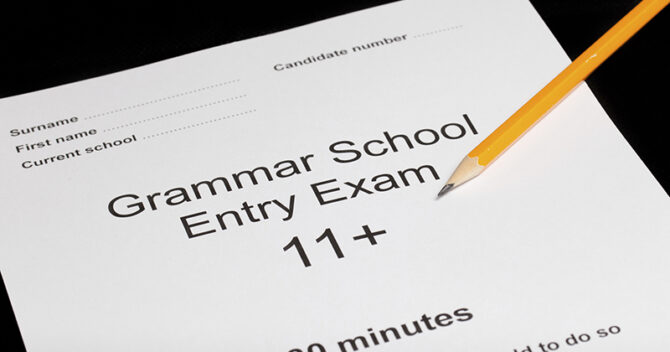
The expansion policy may allow grammar schools to appear like they are opening the door, but the reality is that the bright, disadvantaged students who would benefit from them the most are still being shut out.
By Nazarul Islam
We keep noticing sign boards of (English Medium) Grammar Schools in the nooks and corners of towns and cities, all over the Indian subcontinent, including those in Pakistan and Bangladesh. These schools advertise to offer, what seems unimaginable in elementary education, exclusively for the children of the local neighborhood. In England, Grammar schools are recognized as state secondary schools that select their pupils by means of an examination taken by children at age 11, known as the “11-plus”.
There exist only about 163 grammar schools in England, out of some 3,000 state secondaries, and a further 69 grammar schools in Northern Ireland.
Under the grammar school system, pupils who pass the exam can go to the local grammar, while those who do not go to the local “secondary modern school”.
More common across the UK is the “comprehensive” system, in which pupils of all abilities and aptitudes are taught together.
There are no state grammars in Wales or Scotland, and although some retain the name “grammar school”, they are non-selective and have no special status.
Covid has exacerbated the disparities in our education system, and almost two years on since the start of the pandemic, it appears that support continues to be given in the wrong places. British National Tutoring catch-up program has been a resounding failure, with only 5% of the target number of pupils having been enrolled so far.
On the other hand, a recent Freedom of Information request has revealed that grammar schools in Kent are taking significant numbers of pupils that have not passed the 11-Plus, thereby giving them an unfair advantage.
Grammar schools have been allowed to expand but the number of students taking — and passing — the 11-Plus has failed to keep pace, and therefore more and more places are being given on appeals. For example, in the Herne Bay area, around 10% of grammar school places are now given through appeals, whilst across the county 35% of 11-Plus applicants go to grammar schools, despite the target being 25%.
However, there is an argument that, aside from the knock-on effects on neighboring comprehensives, this may be a good thing. Grammar schools tend to get excellent results; in The Times’ Parent Power 2022 school rankings, all of the top 20 state secondary schools are grammar schools, and 16 of these are based in London and the South East. In theory that means that the more students that get the opportunity to go to a high-achieving school, the better.
Again, there is also an argument that allows such grammar schools to expand, but not the new grammar schools likely to be built, which has only exacerbated regional inconsistencies. Kent is already an anomaly in many respects. It has 35 selective schools, by far the most of any area in England; the next largest is Lincolnshire, with 15.
By contrast, there is not a single grammar school in the whole of East Anglia (Norfolk, Suffolk, and Cambridgeshire), nor in Oxfordshire, Somerset, Northumberland or Durham. Kent is also a very affluent area. The average price of a house in Sevenoaks is over £700,000, with an average household income of £60,000.
Grammar schools are often accused of taking disproportionately high numbers of wealthy pupils, and it’s not hard to see why when you look at house prices: in Buckinghamshire, where there are 13 grammar schools, almost 9% of houses sold last year went for over £1 million.
Middle-class families in areas such as Tunbridge Wells and Cranbook will not only be able to afford the costs of living near a good grammar school, but they will also be able to fund private tuition to coach their children through the 11-Plus. If they fail, they will also know how to play the appeals system, and grammar schools, desperate to get more funding through expansion will give more and more places based on money rather than merit.
Many schools are already lowering the pass mark to fill the growing number of places. This not only makes a mockery of the 11-Plus exams (which are contentious enough already), but it also highlights the broken postcode lottery of our education system.
Blackpool, for example, is regularly listed as one of the most deprived areas in the country, but the nearest grammar school is just under an hour drive away. Colchester in Essex, a smaller and much wealthier town, has two, while Southend-on-Sea, which has a similar population to Blackpool, has four — the same number as the whole of Lancashire, the second most populous county in England.
If the government is serious about ‘levelling up’ then it either needs to limit the expansion of existing grammar schools, or consider allowing the introduction of new ones. Our current system does nothing for social mobility whilst grammar schools are so concentrated in affluent areas.
The expansion policy may allow grammar schools to appear like they are opening the door, but the reality is that the bright, disadvantaged students who would benefit from them the most are still being shut out.
[author title=”Nazarul Islam ” image=”https://sindhcourier.com/wp-content/uploads/2021/05/Nazarul-Islam-2.png”]The Bengal-born writer Nazarul Islam is a senior educationist based in USA. He writes for Sindh Courier and the newspapers of Bangladesh, India and America. He is author of a recently published book ‘Chasing Hope’ – a compilation of his 119 articles.[/author]